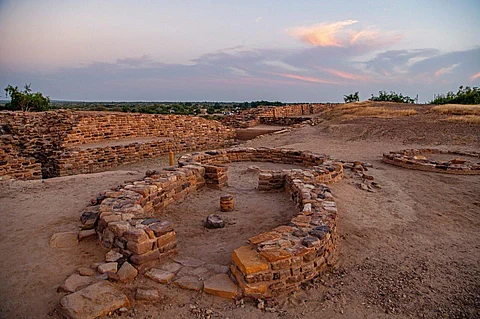

Harappa and Mohenjo-daro have been on my wish list since I read about them in my school textbooks. Despite being right next door, they are not the easiest places to visit for an Indian. I still hope that I will be able to visit them one day. The news of Dholavira getting the much-deserved UNESCO World Heritage Site tag made me think of the Sindhu Sarasvati valley civilisation heritage we have in India. Most of it can be found in museums across the country on display as proud remnants of a highly developed civilisation of which we are the descendants.
Of the heritage sites of the Indus Valley civilisation, Lothal in the Gulf of Khambhat is a unique one both because it is accessible to the general public and is probably the oldest known dockyard in the world. When you walk around the ruins of the city that looks more like the foundations of an unfinished building, you have to stretch your imagination to think of it as a bustling international trade centre that connected India to the world over the sea route thousands of years ago. What I remember most from this site is the kiln and the bead-making factory. The microbeads in sparkling white colour can still be seen at the site museum along with other excavated material. The beads are so minute that you need to use a magnifying glass to appreciate their shape and the holes within. One wonders about the technology used to craft such miniature beads or even where they were used besides being part of jewellery. Another thing that I remember is the baked bricks in an isosceles trapezoid shape, designed such that they come together perfectly in a circle to line a circular well.
A visit to the small museum in Ropar near Chandigarh told me that the planned city of Chandigarh was actually built on top of the ancient planned city of Indus Valley civilisation. The museum located right next to the excavated mound has artifacts that we now identify with this civilisation like burial pottery, beads, toys and terracotta figurines. Sanghol is another Indus Valley site located not too far from Chandigarh, on the way to Ludhiana. The village is more popularly known as Uccha Pind. Based on excavations, it is dated back to the late Harappan period that was potentially inhabited right upto the Kushan era. You can see sculptures excavated from here at the site museum as well as at Chandigarh Museum.
The Dancing Girl of Mohenjo-daro invariably takes us back to school history books, but not many know that you can see her at the National Museum in Delhi. One may be a bit disappointed to find her much smaller than we imagined, at just about four inches in height. But being face to face with her is like getting transported to the era when she must have been cast using the lost wax method, a technique that continues to be practiced in remote corners of India. The gallery also has the seals, painted pottery and large funeral mounds on display. I also remember the skeleton of a buried woman from Rakhigarhi—one of the oldest and largest of the Indus Valley sites in Hisar district of Haryana. Rakhigarhi and Sinauli in Western Uttar Pradesh as of now are not so accessible to the general public but I hope to visit them or their artifacts as and when possible.
On the west coast, on the island of Beyt Dwarka, marine archaeological excavations have revealed late Harappan period material including a typical Indus Valley seal, pottery, an inscribed jar, a copper object, a coppersmith’s stone mould used for casting spearheads, etc. Remember, the island, surrounded by the sea, must have undergone massive corrosion, yet glimpses of the past have managed to survive more or less in situ.
Kalibangan in Hanumangarh district of Rajasthan is supposedly located at the confluence of the Sarasvati and Drishadvati rivers that mark the boundary of Kurukshetra in Mahabharata. Like typical Indus Valley sites, it has an upper city and a lower city, with the latter being the earlier site. Some even call it pre-Harappan. Cities are designed in a grid pattern aligned to cardinal directions. There are usual markers of the civilisation like the use of clay and burnt bricks, seals, pottery, terracotta figures and burial pits. There are fire altars for rituals. However, this site stands out for the evidence of ploughed fields, the earliest known one.
There are some things that we know about the Sindhu Sarasvati civilisation, but there is a lot we do not know and are yet to uncover, decipher and understand. I hope that we not only learn the sophisticated town planning from our ancestors but also understand what led to their steep and probably sudden downfall.
Anuradha Goyal
(Tweets @anuradhagoyal)
Author and founder of blogging website IndiTales